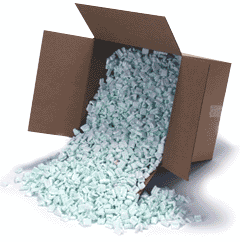
Oh, whoa to the one who opens the package filled with packing peanuts.
 Foam-in-place packaging saves you the headache of traditional packing peanuts.
Foam-in-place packaging saves you the headache of traditional packing peanuts.How many times have you opened a shipment and seen nothing but a sea of packing peanuts looking back at you?
You realize that you're about to make an unholy mess trying to find your item (or items) and then you're going to have to make sure to clean up said mess before your kids or pets find them and those tiny, obnoxious little peanuts are strewn throughout your house.
As a consumer, you think that there has got to be a better way to protect those delicate or awkwardly shaped products you've purchased without having to spend the next 2 weeks picking up those (apparently) actively multiplying devils made of styrofoam.
As a shipper, you want to ensure that your products arrive protected and undamaged. Because you certainly don't want to be on the receiving end of the screaming phone call from a unhappy customer who opened up their package to find their shipment shattered thanks to inadequate interior packaging.
So, what can you do to make your life easier, keep your customers satisfied, AND make sure that your products make it through the nightmare of shipping unscathed?
Let me take this opportunity to introduce you to a new technology in customizable interior cushioning: foam-in-place packaging.
Foam-in-place provides unique customized cushioning properties. It is extremely versatile because it molds around the product it is protecting. This molding happens when two liquid chemicals are injected into a high density polyethylene bag; once this happens, the reaction begins to “foam” and expand to surround the item, filling the void between the container and the product, creating a completely custom protective shell.
- This technology offers the highest degree of product protection available.
- It allows operators to work smarter and more simply for maximum productivity.
- It reduces or eliminates damage expense.
- Its small footprint maximizes space and cost efficiency, while increasing consumer confidence.
 The footprint of foam-in-place packaging is a fraction of that of traditional void fill like packing peanuts.
The footprint of foam-in-place packaging is a fraction of that of traditional void fill like packing peanuts.One of the biggest problems with packaging peanuts (besides the obvious above stated ones) is the incredible amount of storage space that they require at your facility. The foam-in-place systems require a small footprint for the machine and the two chemical containers. When you consider the cost of a facility space today, a smaller footprint can save you thousands of dollars a year.
Where foam-in-place packaging makes the most sense
The really fancy technology sounds great. And you know that products need snug and lightweight protection to assure customer satisfaction and cost-effective shipping.
But where do these machines really make the most sense?
- Home-based businesses are especially cost-bound to packaging and ship safely and efficiently.
- Furniture and appliances are heavily discounted when they have surface scratches.
- Shipping stores and business mailrooms ship with various options, but they rely on the low cost, speed, and minimal space of shipping equipment and supplies.
- Retail and e-commerce have new reasons to consider the value of “free” shipping offers.
- Museums and antiques need protection for sensitive and fragile materials.
- Medical products should arrive cleanly, as well as safely.
- Electronics include sensitive parts and glass requiring protection and separation.







